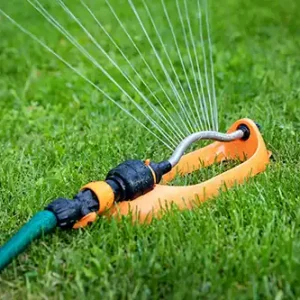HOW OFTEN SHOULD I WATER MY LAWN IN THE SUMMER?
Watering your lawn on a daily basis is typically unnecessary, and could even lead to problems like pests or diseases.
Frequent daily watering for your lawn is usually redundant and could even invite issues such as pests or diseases. Instead, strive to provide your lawn with around 1 inch of water on a weekly basis by adopting a deep and infrequent watering approach. Afterward, closely monitor your lawn’s performance and make necessary alterations as needed.

What Happens If I Water My Lawn Too Frequently?
Allowing your grass to go a few days without watering may initially be counterintuitive, particularly when the weather is hot and dry. Nevertheless, overly frequent watering exposes your lawn to a higher risk of various issues, including:
- Thatch accumulation: Thatch, a layer of partially decomposing plant matter that develops over the soil’s surface, naturally breaks down in dry conditions. However, continual moisture hinders its decomposition. This not only creates a welcoming environment for pests and fungus but also suffocates your grass.
- Fungus, weeds, and pests: Fungus thrives in very damp environments, making lawns perpetually soaked more susceptible to disease. Numerous pests and weeds are also attracted to areas with abundant moisture, resulting in a higher incidence of infestations in over-watered lawns.
- Shallow root system: Keeping the soil consistently moist makes it easy for your grass to take in water without the incentive to grow deep root systems. Shallow roots can leave your lawn more susceptible to diseases and other issues.
- Wasteful watering: Watering your lawn every day is not only a misuse of your time and money but also an unnecessary drain on precious natural resources. To keep your utility bills in check and play your part in environmental conservation, it’s best to avoid overwatering, especially during drought conditions.
Ready for your INSTANT quote?
Click the button below to leave your information and we’ll be in touch with a free quote!
HOW MUCH WATER DOES MY LAWN NEED?
Determining the ideal amount of water for your lawn involves understanding your grass type, soil composition, and local climate. Generally, warm-season grasses like Bermuda and St. Augustine thrive in Florida’s climate, requiring about 1 to 1.5 inches of water per week during the growing season. However, it’s crucial not to overwater, as this can lead to shallow root systems. Deep watering encourages deeper root growth, making your lawn more resilient to drought and stress.
HOW OFTEN SHOULD I WATER MY LAWN AFTER FERTLIZING?
After fertilizing your lawn, it’s essential to adjust your watering schedule accordingly. Typically, it’s best to water your lawn deeply and less frequently, allowing the fertilizer to penetrate the soil and reach the grass roots effectively. Aim to water your lawn early in the morning to reduce water loss through evaporation and minimize the risk of fungal diseases. Depending on your soil type and grass species, you may need to water two to three times a week, ensuring your lawn receives about 1 to 1.5 inches of water per week.
WATERING WITH A SPRINKLER SYSTEM
Efficiently using a sprinkler system is vital for a healthy lawn. It’s important to fully understand your soil’s drainage and the sprinkler distribution. Adjust the system for even coverage, avoiding overwatering or underwatering. For cool-season grasses like Kentucky bluegrass, deep but infrequent watering is best, while warm-season grasses like Zoysia benefit from frequent, shallow watering. Install a timer to water early morning, reducing bills and maximizing absorption.
WATERING WITHOUT A SPRINKLER SYSTEM
Even without one, you can water effectively. Use a hose-end sprinkler or watering wand to mimic coverage. Adjust watering based on grass type; sandy soils need more frequent, shorter watering to prevent runoff, while clay soils benefit from less frequent, deep watering. Opt for early morning watering to minimize evaporation and promote deeper root growth.
Should You Water Your Lawn After Rain?
No, there’s no need to water your lawn when heavy rain is already providing moisture. In fact, it’s essential to account for rainfall to prevent unintentional overwatering of your grass. In total, aim to provide your lawn with 1-1.5 inches of water, even when it rains. Adjust your watering regimen if your lawn appears excessively damp or shows signs of dehydration.
Creating an effective watering schedule can be difficult, especially considering that your lawn’s requirements evolve with the changing seasons. If you want outstanding results without the hassle, don’t hesitate to reach out to a lawn care expert. They are committed to maintaining your landscape in optimal condition and will collaborate with you to establish an effective watering routine.
How Do I Know If My Grass & lawn Has a Disease? Serving Orlando and surrounding counties
Serving satisfied customers in:


